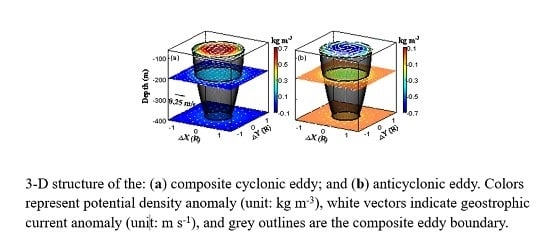Vertical Structure Anomalies of Oceanic Eddies and Eddy-Induced Transports in the South China Sea
Abstract
1. Introduction
2. Data and Methodology
2.1. Data
2.2. Eddy Detection Scheme
2.3. The Background and Anomaly Data Selection Method
2.4. Definition of the Mixed Layer Depth
2.5. Composite Analysis Method
2.6. Eddy-Induced Heat and Freshwater Transports
3. Statistical Characteristics and the Composite 3-D Structures of Eddies
3.1. Eddy Distribution and Evolution
3.2. Composite 3-D Eddy Structure
4. Eddy-Induced Anomaly
4.1. Eddy-Induced Geostrophic Current Anomaly
4.2. Eddy-Induced Temperature, Salinity and Potential Density Anomaly
4.3. Composite Eddy-Modulated Mixed Layer Depth Anomaly
5. Eddy-Induced Heat and Freshwater Transports
6. Discussion
7. Conclusions
Author Contributions
Acknowledgments
Conflicts of Interest
Appendix A. Argo Quality Controlling Method
- The data mode must be delayed or real-time with adjustment mode and quality flag must be “1” which indicates “good”.
- The minimum observation pressure must be less than 20 dbar.
- The deviation between two consecutive pressure records must be less than a given threshold (), which depends on pressure range ( for the 0–100 dbar layer, for the 100–300 dbar layer, and for more than 300 dbar layer).
- The maximum deviation of temperature and potential density from the minimum pressure layer to the other layers must be larger than 0.2 °C and 0.03 kg m−3, respectively.
- Besides the four constraints for quality control mentioned above, the retained data levels in each profile must be more than or equal to 30.
Appendix B. Eddy Detection Scheme and Eddy Horizontal Movement Velocity
References
- Su, J.; Xu, J.; Cai, S.; Wang, O. Gyres and eddies in the South China Sea. In Onset and Evolution of the South China Sea Monsoon and Its Interaction with the Ocean; Ding, Y., Li, C., Eds.; Meteorol. Press: Beijing, China, 1999; pp. 272–279. [Google Scholar]
- Shaw, P.T.; Chao, S.Y.; Fu, L. Sea surface height variations in the South China Sea from satellite altimetery. Oceanol. Acta 1999, 22, 1–17. [Google Scholar] [CrossRef]
- Hwang, C.; Chen, S. Circulations and eddies over the South China Sea derived from TOPEX/Poseidon altimetry. J. Geophys. Res. 2000, 105, 23943–23965. [Google Scholar] [CrossRef]
- Wang, G.; Su, J.; Chu, P.C. Mesoscale eddies in the South China Sea detected from altimeter data. Geophys. Res. Lett. 2003, 30, 2121. [Google Scholar] [CrossRef]
- Faghmous, J.H.; Frenger, I.; Yao, Y.; Warmka, R.; Lindell, A.; Kumar, V. A daily global mesoscale ocean eddy dataset from satellite altimetry. Sci. Data 2015, 2. [Google Scholar] [CrossRef] [PubMed]
- Sun, M.; Tian, F.; Liu, Y.; Chen, G. An improved automatic algorithm for global eddy tracking using satellite altimeter data. Remote Sens. 2017, 9, 206. [Google Scholar] [CrossRef]
- Lin, X.; Dong, C.; Chen, D.; Liu, Y.; Yang, J.; Zou, B.; Guan, Y. Three-dimensional properties of mesoscale eddies in the South China Sea based on eddy-resolving model output. Deep Sea Res. 2015, 99, 46–64. [Google Scholar] [CrossRef]
- Dale, W. Wind and drift current in the South China Sea. Malaysian J. Trop. Geogr. 1956, 8, 1–31. [Google Scholar]
- Chelton, D.B.; Schlax, M.G.; Samelson, R.M.; De Szoeke, R.A. Global observations of large oceanic eddies. Geophys. Res. Lett. 2007, 34, 87–101. [Google Scholar] [CrossRef]
- Chelton, D.B.; Gaube, P.; Schlax, M.G.; Early, J.J.; Samelson, R.M. The influence of nonlinear mesoscale eddies on near-surface oceanic chlorophyll. Science 2011, 334, 328–332. [Google Scholar] [CrossRef] [PubMed]
- Chen, G.; Gan, J.; Xie, Q.; Chu, X.; Wang, D.; Hou, Y. Eddy heat and salt transports in the South China Sea and their seasonal modulations. J. Geophys. Res. 2012, 117. [Google Scholar] [CrossRef]
- Gaube, P.; McGillicuddy, D.J.; Chelton, D.B.; Behrenfeld, M.J.; Strutton, P.G. Regional variations in the influence of mesoscale eddies on near-surface chlorophyll. J. Geophys. Res. 2014, 119. [Google Scholar] [CrossRef]
- Dong, C.; McWilliams, J.C.; Liu, Y.; Chen, D. Global heat and salt transports by eddy movement. Nat. Commun. 2014, 5. [Google Scholar] [CrossRef] [PubMed]
- Zhang, Y.; Liu, Z.; Zhao, Y.; Wang, W.; Li, J.; Xu, J. Mesoscale eddies transport deep-sea sediments. Sci. Rep. 2014, 4, 5937. [Google Scholar] [CrossRef] [PubMed]
- Zhang, Z.; Wang, W.; Qiu, B. Oceanic mass transport by mesoscale eddies. Science 2014, 345, 322–324. [Google Scholar] [CrossRef] [PubMed]
- Zhang, Z.; Zhong, Y.; Tian, J.; Yang, Q.; Zhao, W. Estimation of eddy heat transport in the global ocean from Argo data. Acta Oceanol. Sin. 2014, 33, 42–47. [Google Scholar] [CrossRef]
- He, Q.; Zhan, H.; Cai, S.; Li, Z. Eddy effects on surface chlorophyll in the northern South China Sea: Mechanism investigation and temporal variability analysis. Deep Sea Res. 2016, 112, 25–36. [Google Scholar] [CrossRef]
- McGillicuddy, D.J., Jr. Mechanisms of Physical-Biological-Biogeochemical interaction at the oceanic mesoscale. Ann. Rev. Mar. Sci. 2016, 8, 125–159. [Google Scholar] [CrossRef] [PubMed]
- He, Q.; Zhan, H.; Shuai, Y.; Cai, S.; Li, Q.; Huang, G.; Li, J. Phytoplankton bloom triggered by an anticyclonic eddy: The combined effect of eddy-Ekman pumping and winter mixing. J. Geophys. Res. 2017, 122, 4886–4901. [Google Scholar] [CrossRef]
- Rubio, A.; Caballero, A.; Orfila, A.; Hernández-Carrasco, I.; Ferrer, L.; González, M.; Solabarrieta, L.; Mader, J. Eddy-induced cross-shelf export of high Chl-a coastal waters in the se bay of Biscay. Remote Sens. Environ. 2018, 205, 290–304. [Google Scholar] [CrossRef]
- Hausmann, U.; Czaja, A. The observed signature of mesoscale eddies in sea surface temperature and the associated heat transport. Deep Sea Res. 2012, 70, 60–72. [Google Scholar] [CrossRef]
- Dong, D.; Brandt, P.; Chang, P.; Schütte, F.; Yang, X.; Yan, J.; Zeng, J. Mesoscale eddies in the northwestern pacific ocean: Three-dimensional eddy structures and heat/salt transports. J. Geophys. Res. 2017, 122, 9795–9813. [Google Scholar] [CrossRef]
- Byrne, D.; Munnich, M.; Frenger, I.; Gruber, N. Mesoscale atmosphere ocean coupling enhances the transfer of wind energy into the ocean. Nat. Commun. 2016, 7. [Google Scholar] [CrossRef] [PubMed]
- Frenger, I.; Gruber, N.; Knutti, R.; Münnich, M. Imprint of Southern Ocean eddies on winds, clouds and rainfall. Nat. Geosci. 2013, 6, 608–612. [Google Scholar] [CrossRef]
- Ma, J.; Xu, H.; Dong, C.; Lin, P.; Liu, Y. Atmospheric responses to oceanic eddies in the Kuroshio Extension region. J. Geophys. Res. 2015, 120, 6313–6330. [Google Scholar] [CrossRef]
- Villas Bôas, A.B.; Sato, O.T.; Chaigneau, A.; Castelão, G.P. The signature of mesoscale eddies on the air-sea turbulent heat fluxes in the South Atlantic Ocean. Geophys. Res. Lett. 2015, 42, 1856–1862. [Google Scholar] [CrossRef]
- Chu, P.C.; Fan, C. Low salinity, cool-core cyclonic eddy detected northwest of Luzon during the South China Sea Monsoon Experiment (SCSMEX) in July 1998. J. Oceanogr. 2001, 57, 549–563. [Google Scholar] [CrossRef]
- Chen, G.; Hou, Y.; Zhang, Q.; Chu, X. The eddy pair off eastern Vietnam: Interannual variability and impact on thermohaline structure. Cont. Shelf. Res. 2009, 30, 715–723. [Google Scholar] [CrossRef]
- Nan, F.; He, Z.; Zhou, H.; Wang, D. Three long-lived anticyclonic eddies in the northern South China Sea. J. Geophys. Res. 2011, 116. [Google Scholar] [CrossRef]
- Hu, J.; Gan, J.; Sun, Z.; Zhu, J.; Dai, M. Observed three-dimensional structure of a cold eddy in the southwestern South China Sea. J. Geophys. Res. 2011, 116, 86. [Google Scholar] [CrossRef]
- Zhang, Z.; Zhang, Y.; Wang, W.; Huang, R. Universal structure of mesoscale eddies in the ocean. Geophys. Res. Lett. 2013, 40, 3677–3681. [Google Scholar] [CrossRef]
- Chu, X.; Xue, H.; Qi, Y.; Chen, G.; Mao, Q.; Wang, D.; Chai, F. An exceptional anticyclonic eddy in the South China Sea in 2010. J. Geophys. Res. 2014, 119, 881–897. [Google Scholar] [CrossRef]
- Chen, G.; Wang, D.; Dong, C.; Zu, T.; Xue, H.; Shu, Y.; Chu, X.; Qi, Y.; Chen, H. Observed deep energetic eddies by seamount wake. Sci. Rep. 2015, 5. [Google Scholar] [CrossRef] [PubMed]
- Zhang, Z.; Tian, J.; Qiu, B.; Zhao, W.; Chang, P.; Wu, D.; Wan, X. Observed 3D structure, generation, and dissipation of oceanic mesoscale eddies in the South China Sea. Sci. Rep. 2016, 6, 24349. [Google Scholar] [CrossRef] [PubMed]
- Xiu, P.; Chai, F.; Shi, L.; Xue, H.; Chao, Y. A census of eddy activities in the South China Sea during 1993–2007. J. Geophys. Res. 2010, 115. [Google Scholar] [CrossRef]
- Chen, G.; Hou, Y.; Chu, X. Mesoscale eddies in the South China Sea: Mean properties, spatiotemporal variability, and impact on thermohaline structure. J. Geophys. Res. 2011, 116. [Google Scholar] [CrossRef]
- Zeng, L.; Wang, D.; Du, Y.; Shi, P. Mesoscale structure of the central South China Sea detected by SCSMEX Buoy and Argo float. Chin. J. Oceanol. Limnol. 2010, 28, 1102–1111. [Google Scholar] [CrossRef]
- Chaigneau, A.; Le Texier, M.; Eldin, G.; Grados, C.; Pizarro, O. Vertical structure of mesoscale eddies in the eastern South Pacific Ocean: A composite analysis from altimetry and Argo profiling floats. J. Geophys. Res. 2011, 116. [Google Scholar] [CrossRef]
- Yang, G.; Wang, F.; Li, Y.; Lin, P. Mesoscale eddies in the northwestern subtropical Pacific Ocean: Statistical characteristics and three-dimensional structures. J. Geophys. Res. 2013, 118, 1906–1925. [Google Scholar] [CrossRef]
- Sun, W.; Dong, C.; Wang, R.; Liu, Y.; Yu, K. Vertical structure anomalies of oceanic eddies in the Kuroshio Extension region. J. Geophys. Res. 2017, 122, 1476–1496. [Google Scholar] [CrossRef]
- Wu, C.R.; Chiang, T.L. Mesoscale eddies in the northern South China Sea. Deep Sea Res. 2007, 54, 1575–1588. [Google Scholar] [CrossRef]
- Zhang, Z.; Zhao, W.; Tian, J.; Liang, X. A mesoscale eddy pair southwest of Taiwan and its influence on deep circulation. J. Geophys. Res. 2013, 118, 6479–6494. [Google Scholar] [CrossRef]
- Waite, A.M.; Stemmann, L.; Guidi, L.; Calil, P.H.R.; Hogg, A.M.C.; Feng, M.; Thompson, P.A.; Picheral, M.; Gorsky, G. The wineglass effect shapes particle export to the deep ocean in mesoscale eddies. Geophys. Res. Lett. 2016, 43, 9791–9800. [Google Scholar] [CrossRef]
- Pujol, M.I.; Faugère, Y.; Taburet, G.; Dupuy, S.; Pelloquin, C.; Ablain, M.; Picot, N. DUACS DT2014: The new multi-mission altimeter data set reprocessed over 20 years. Ocean Sci. 2016, 12, 1067–1090. [Google Scholar] [CrossRef]
- Wong, A.P.S.; Johnson, G.C.; Owens, W.B. Delayed-mode calibration of autonomous CTD profiling float salinity data by θ-S climatology. J. Atmos. Oceanic Technol. 2003, 20, 308–318. [Google Scholar] [CrossRef]
- Boccaletti, G.; Ferrari, R.; Foxkemper, B. Mixed layer instabilities and restratification. J. Phys. Oceanogr. 2007, 37, 2228–2250. [Google Scholar] [CrossRef]
- Owens, W.B.; Wong, A.P. An improved calibration method for the drift of the conductivity sensor on autonomous CTD profiling floats by θ–S climatology. Deep Sea Res. 2009, 56, 450–457. [Google Scholar] [CrossRef]
- Nencioli, F.; Dong, C.; Dickey, T.; Washburn, L.; Mcwilliams, J.C. A Vector Geometry-Based Eddy Detection Algorithm and Its Application to a High-Resolution Numerical Model Product and High-Frequency Radar Surface Velocities in the Southern California Bight. J. Atmos. Oceanic Technol. 2010, 27, 564–579. [Google Scholar] [CrossRef]
- Dong, C.; Timothy, M.; Francesco, N.; Jiang, S.; Yusuke, U.; Mcwilliams, J.C.; Tommy, D.; Michael, O.; Zhang, H.; Clark, D.K. An oceanic cyclonic eddy on the lee side of Lanai Island, Hawai’i. J. Geophys. Res. 2009, 114, C10008–C10020. [Google Scholar] [CrossRef]
- Liu, Y.; Dong, C.; Guan, Y.; Chen, D.; Mcwilliams, J.C.; Nencioli, F. Eddy analysis in the subtropical zonal band of the North Pacific Ocean. Deep Sea Res. 2012, 68, 54–67. [Google Scholar] [CrossRef]
- Dong, C.; Lin, X.; Liu, Y.; Nencioli, F.; Chao, Y.; Guan, Y.; Chen, D.; Dickey, T.; Mcwilliams, J.C. Three-dimensional oceanic eddy analysis in the Southern California Bight from a numerical product. J. Geophys. Res. 2012, 117, 92–99. [Google Scholar] [CrossRef]
- Couvelard, X.; Caldeira, R.M.A.; Araújo, I.B.; Tomé, R. Wind mediated vorticity-generation and eddy-confinement, leeward of the Madeira Island: 2008 numerical case study. Dyn. Atmos. Oceans 2012, 58, 128–149. [Google Scholar] [CrossRef]
- Peliz, A.; Boutov, D.; Teles-Machado, A. The Alboran Sea mesoscale in a long term high resolution simulation: Statistical analysis. Ocean Modell. 2013, 72, 32–52. [Google Scholar] [CrossRef]
- Aguiar, A.C.B.; Peliz, Á.; Carton, X. A census of Meddies in a long-term high-resolution simulation. Prog. Oceanogr. 2013, 116, 80–94. [Google Scholar] [CrossRef]
- Park, Y.G.; Choi, A. Long-term changes of South China Sea surface temperatures in winter and summer. Cont. Shelf. Res. 2017, 143, 185–193. [Google Scholar] [CrossRef]
- Holte, J.; Talley, L. A new algorithm for finding mixed layer depths with applications to Argo data and subantarctic mode water formation. J. Atmos. Oceanic Technol. 2009, 26, 1920–1939. [Google Scholar] [CrossRef]
- Castelao, R.M. Mesoscale eddies in the South Atlantic Bight and the Gulf Stream Recirculation region: Vertical structure. J. Geophys. Res. 2014, 119, 2048–2065. [Google Scholar] [CrossRef]
- Yang, G.; Yu, W.; Yuan, Y.; Zhao, X.; Wang, F.; Chen, G.; Liu, L.; Duan, Y. Characteristics, vertical structures, and heat/salt transports of mesoscale eddies in the southeastern tropical Indian Ocean. J. Geophys. Res. 2015, 120, 6733–6750. [Google Scholar] [CrossRef]
- Chaigneau, A.; Eldin, G.; Dewitte, B. Eddy activity in the four major upwelling systems from satellite altimetry (1992–2007). Prog. Oceanogr. 2009, 83, 117–123. [Google Scholar] [CrossRef]
- Roemmich, D.; Gilson, J. Eddy transport of heat and thermocline waters in the North Pacific: A key to interannual/decadal climate variability? J. Phys. Oceanogr. 2001, 31, 675–687. [Google Scholar] [CrossRef]
- Qiu, B.; Chen, S. Eddy-induced heat transport in the subtropical North Pacific from Argo, TMI, and altimetry measurements. J. Phys. Oceanogr. 2005, 35, 458–473. [Google Scholar] [CrossRef]
- Volkov, D.L.; Lee, T.; Fu, L.-L. Eddy-induced meridional heat transport in the ocean. Geophys. Res. Lett. 2008, 35, L20601. [Google Scholar] [CrossRef]
- Chelton, D.B.; Schlax, M.G.; Samelson, R.M. Global observations of nonlinear mesoscale eddies. Prog. Oceanogr. 2011, 91, 167–216. [Google Scholar] [CrossRef]
- Samelson, R.M.; Schlax, M.G.; Chelton, D.B. Randomness, Symmetry, and Scaling of Mesoscale Eddy Life Cycles. J. Phys. Oceanogr. 2014, 44, 1012–1029. [Google Scholar] [CrossRef]
- Pegliasco, C.; Chaigneau, A.; Morrow, R. Main eddy vertical structures observed in the four major Eastern Boundary Upwelling Systems. J. Geophys. Res. 2015, 120, 6008–6033. [Google Scholar] [CrossRef]
- Schütte, F.; Brandt, P.; Karstensen, J. Occurrence and characteristics of mesoscale eddies in the tropical northeastern Atlantic Ocean. Ocean Sci. 2016, 12, 663–685. [Google Scholar] [CrossRef]
- Chu, P.C. P-vector method for determining absolute velocity from hydrographic data. Mar. Technol. Soc. J. 1995, 29, 3–14. [Google Scholar]
- He, J.; He, Y.; Cai, S. Assessing the application of Argo profiling float data to the study of the seasonal variation of the hydrological parameters and the current field east of Luzon Strait. Atmos. Ocean 2012, 50, 77–91. [Google Scholar] [CrossRef]
- Yuan, D.; Zhang, Z.; Chu, P.C.; Dewar, W.K. Geostrophic circulation in the Tropical North Pacific Ocean based on Argo profiles. J. Phys. Oceanogr. 2014, 44, 558–575. [Google Scholar] [CrossRef]
- Fang, G.; Wang, Y.; Wei, Z.; Fang, Y.; Qiao, F.; Hu, X. Interocean circulation and heat and freshwater budgets of the South China Sea based on a numerical model. Dyn. Atmos. Oceans 2009, 47, 55–72. [Google Scholar] [CrossRef]
- Nan, F.; Xue, H.; Yu, F. Kuroshio intrusion into the South China Sea: A review. Prog. Oceanogr. 2015, 137, 314–333. [Google Scholar] [CrossRef]
- Nurser, A.; Zhang, J.W. Eddy-induced mixed layer shallowing and mixed layer/thermocline exchange. J. Geophys. Res. 2000, 105, 21851–21868. [Google Scholar] [CrossRef]
- Herbette, S.; Morel, Y.; Arhan, M. Erosion of a Surface Vortex by a Seamount. J. Phys. Oceanogr. 2003, 33, 1664–1679. [Google Scholar] [CrossRef]
- Haine, T.W.N.; Marshall, J. Gravitational, Symmetric, and Baroclinic Instability of the Ocean Mixed Layer. J. Phys. Oceanogr. 1998, 28, 634–658. [Google Scholar] [CrossRef]
- Yang, Q.; Zhao, W.; Liang, X.; Dong, J.; Tian, J. Elevated mixing in the periphery of mesoscale eddies in the South China Sea. J. Phys. Oceanogr. 2017, 47. [Google Scholar] [CrossRef]
- Thomas, L.N.; Taylor, J.R.; D’Asaro, E.A.; Lee, C.M.; Klymak, J.M.; Shcherbina, A. Symmetric Instability, Inertial Oscillations, and Turbulence at the Gulf Stream Front. J. Phys. Oceanogr. 2015, 46. [Google Scholar] [CrossRef]
- Johnston, T.M.S.; Rudnick, D.L. Observations of the transition layer. J. Phys. Oceanogr. 2009, 39, 780–797. [Google Scholar] [CrossRef]
- Klein, P.; Lapeyre, G. The oceanic vertical pump induced by mesoscale and submesoscale turbulence. Annu. Rev. Mar. Sci. 2009, 1, 351–375. [Google Scholar] [CrossRef] [PubMed]
- Callies, J.; Flierl, G.; Ferrari, R.; Fox-Kemper, B. The role of mixed-layer instabilities in submesoscale turbulence. J. Fluid Mech. 2016, 788, 5–41. [Google Scholar] [CrossRef]
- Doglioli, A.M.; Blanke, B.; Speich, S.; Lapeyre, G. Tracking coherent structures in a regional ocean model with wavelet analysis: Application to Cape Basin eddies. J. Geophys. Res. 2007, 112, C05043. [Google Scholar] [CrossRef]
- Chaigneau, A.; Gizolme, A.; Grados, C. Mesoscale eddies off Peru in altimeter records: Identification algorithms and eddy spatiotemporal patterns. Prog. Oceanogr. 2008, 79, 106–119. [Google Scholar] [CrossRef]
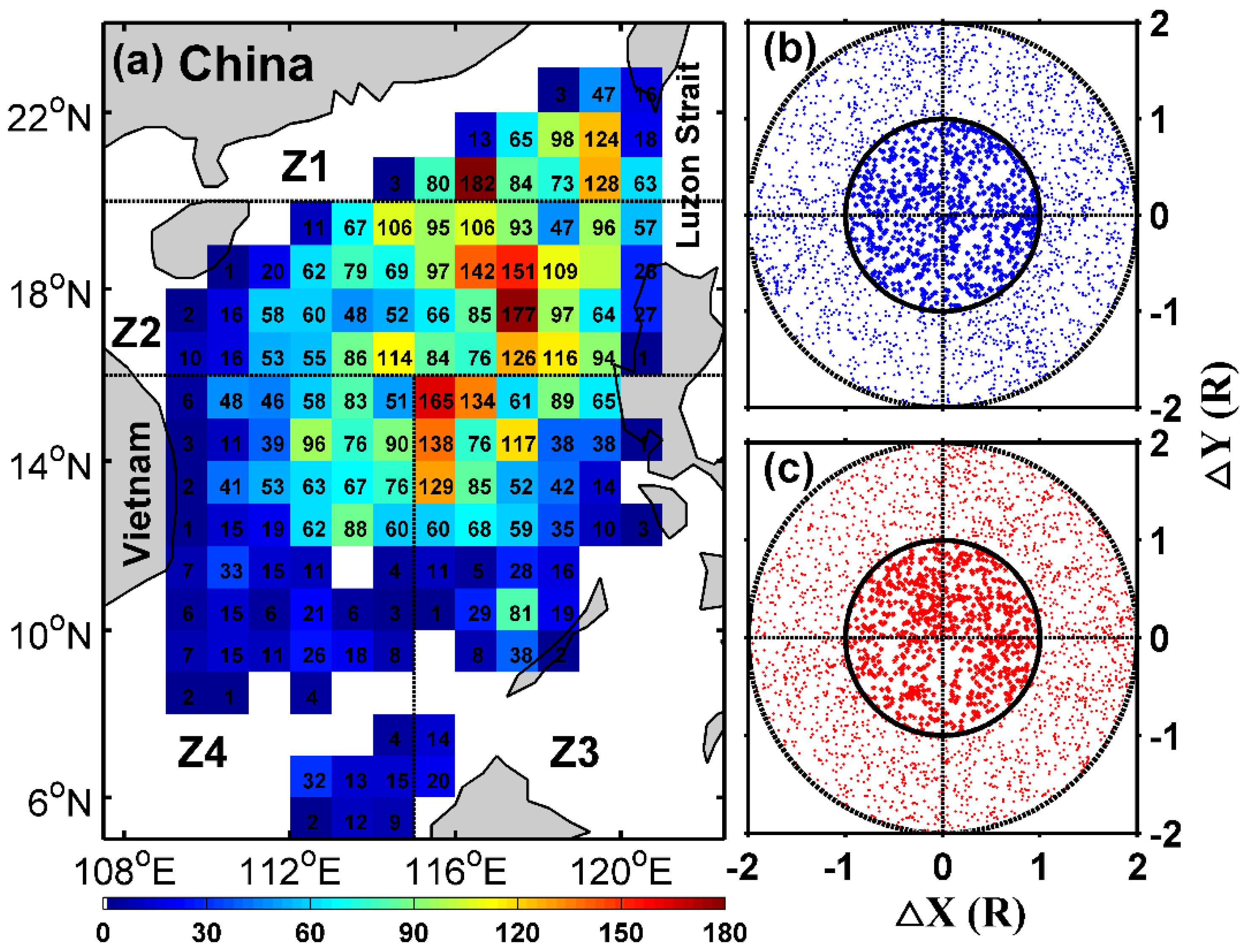
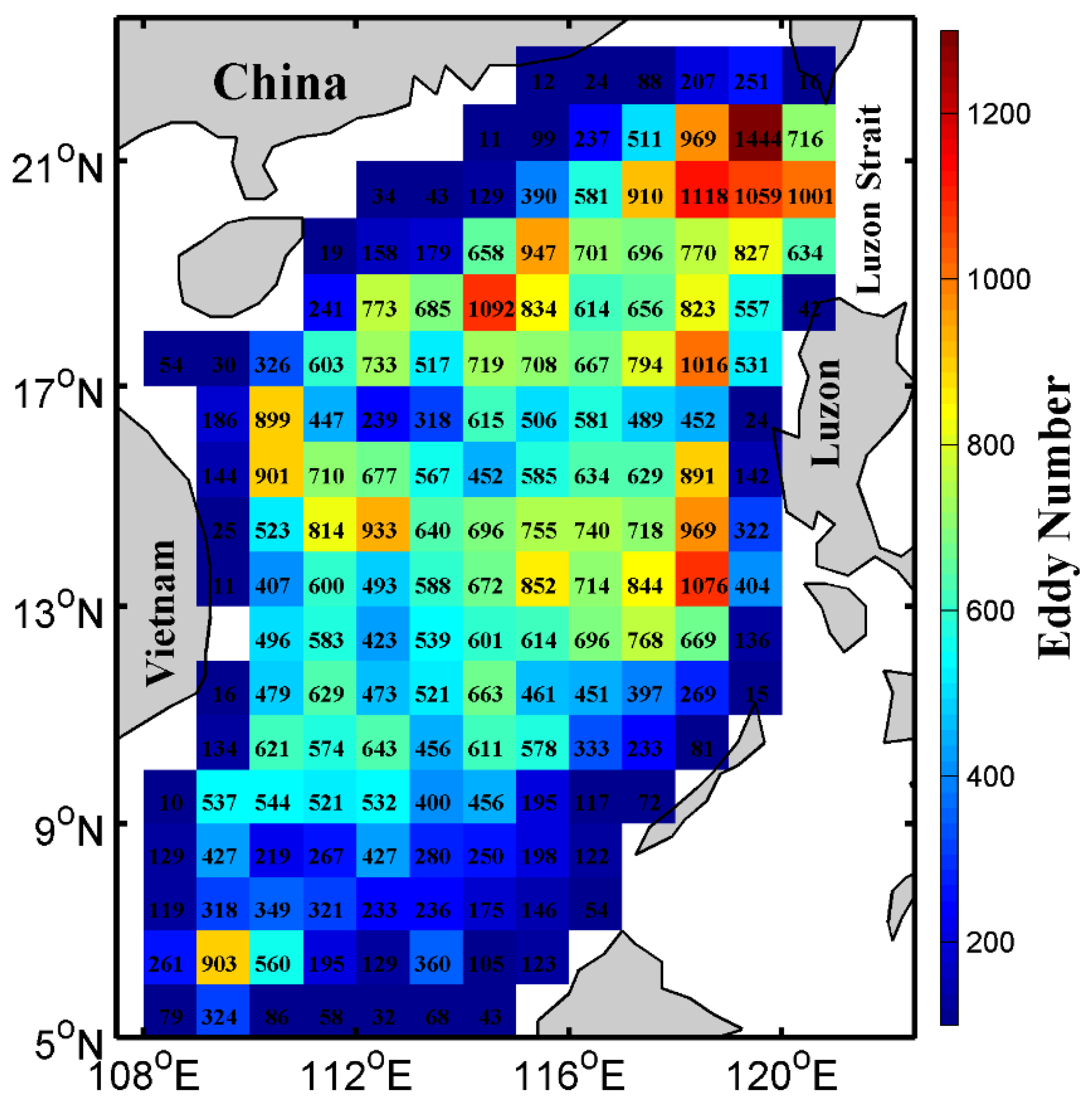
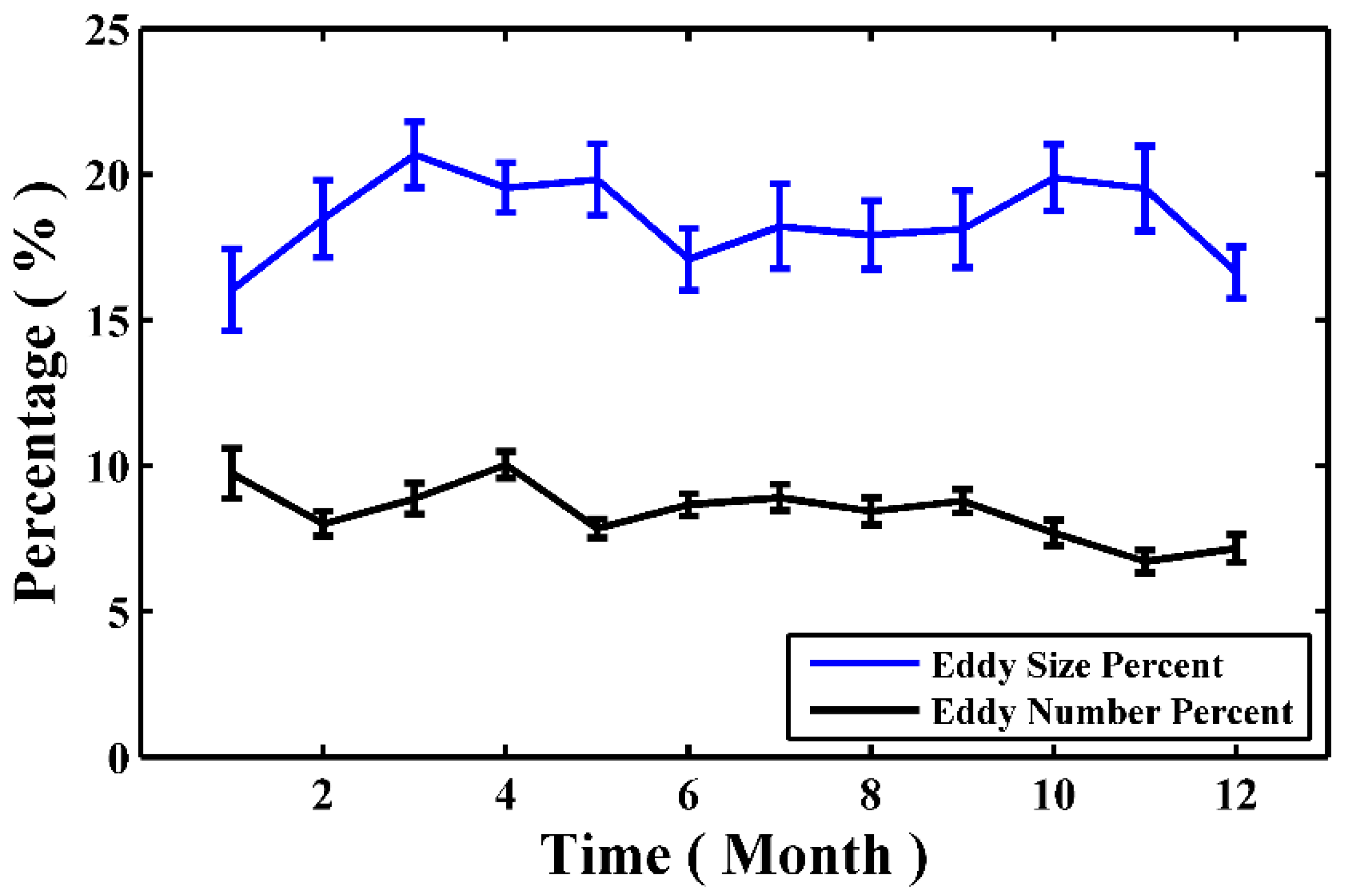
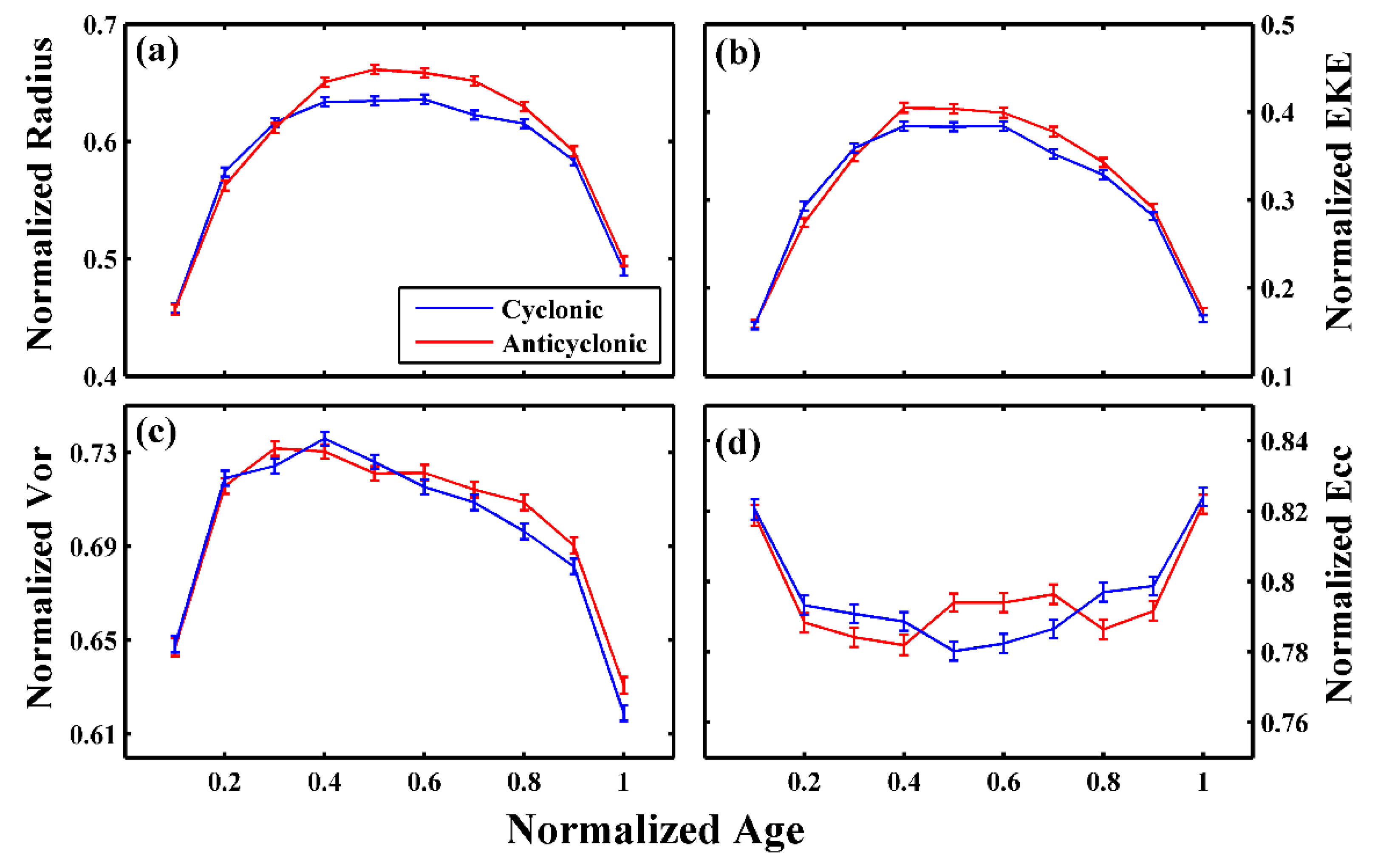

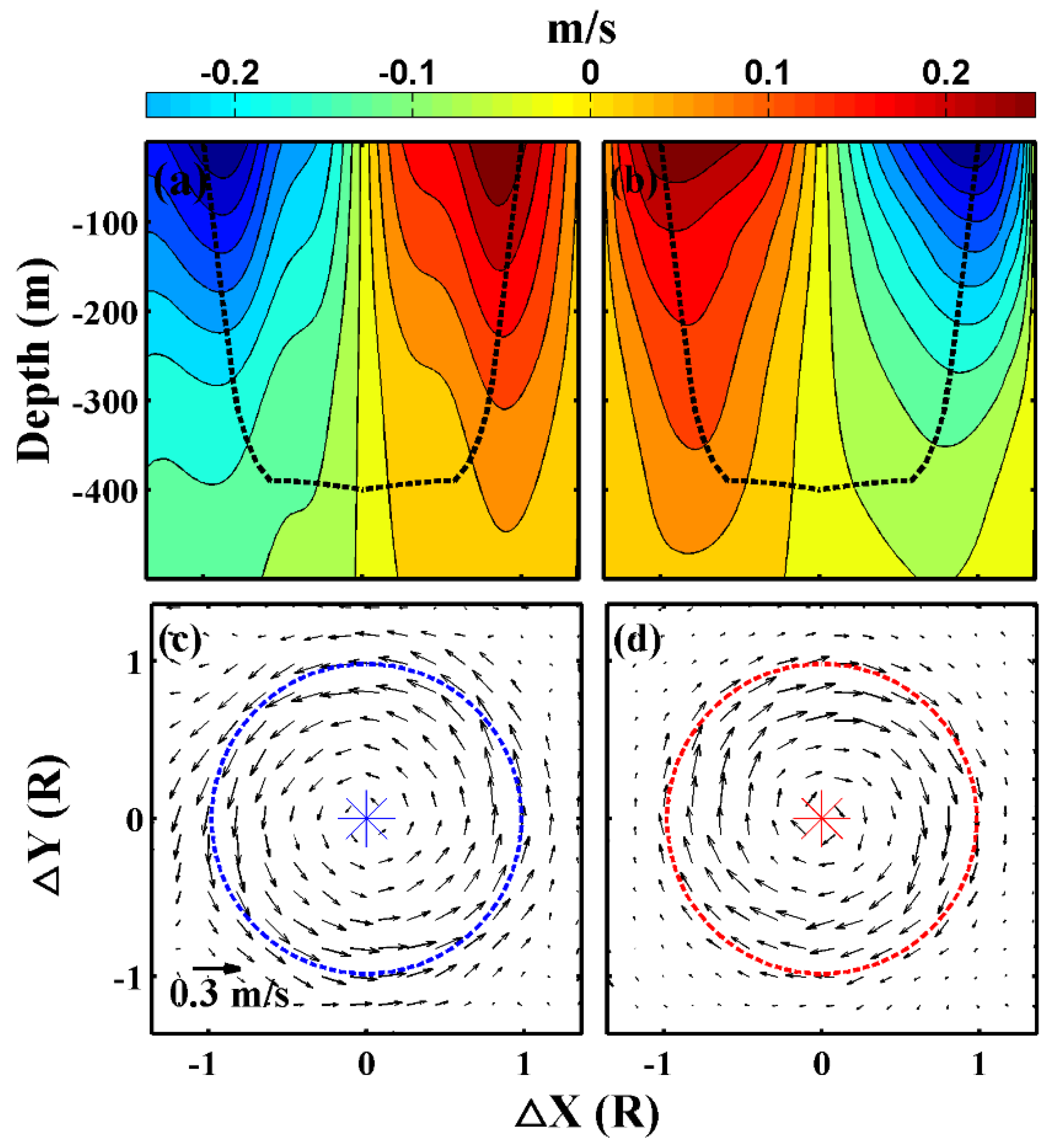
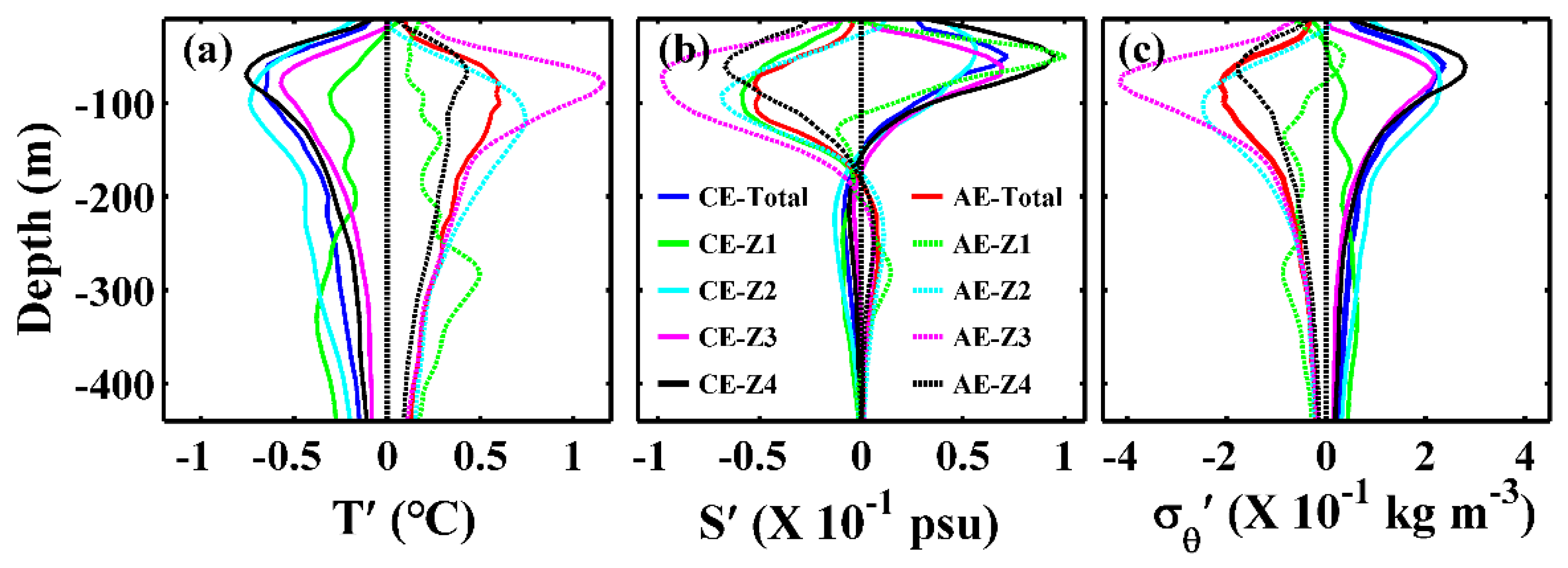


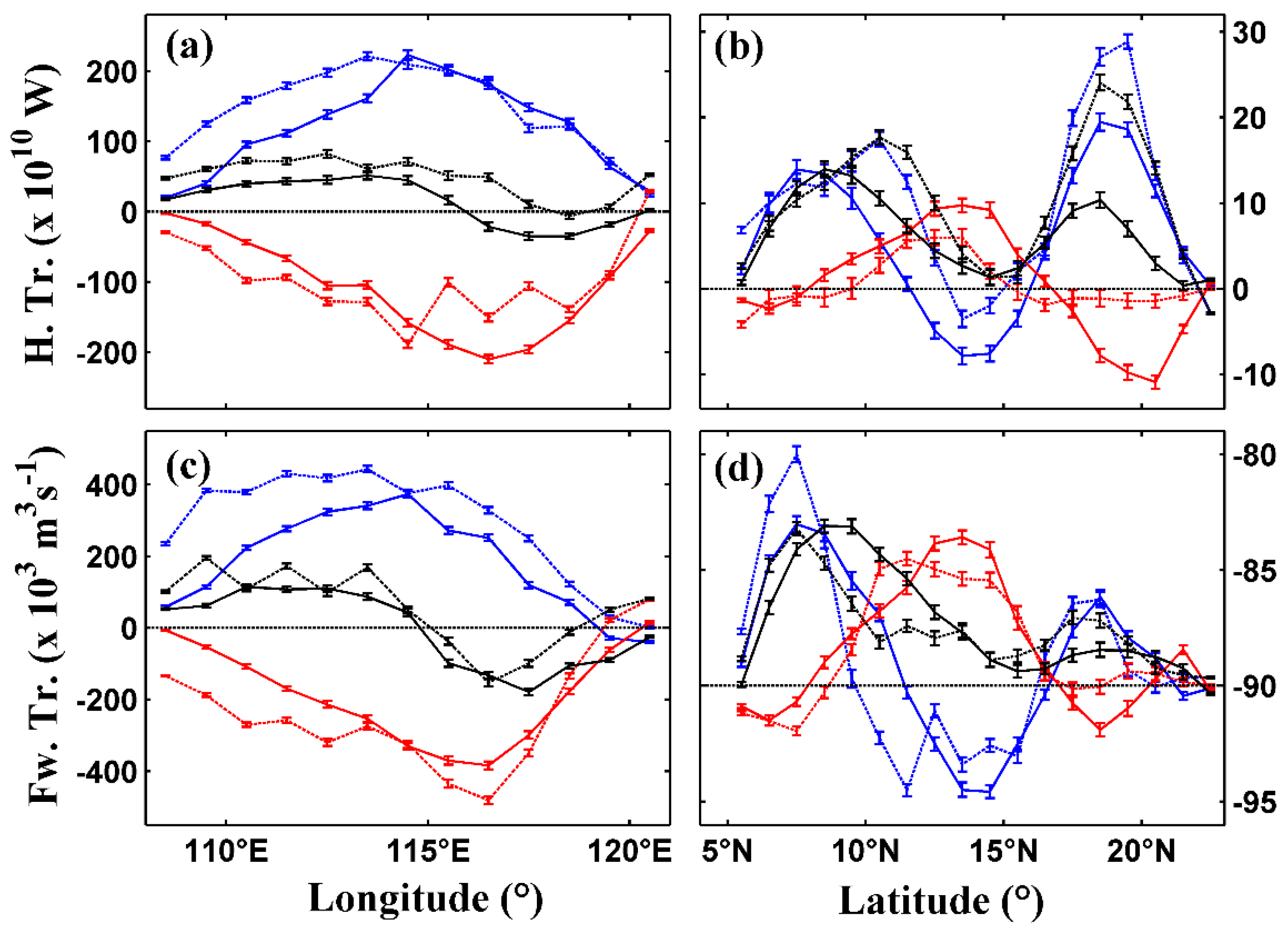
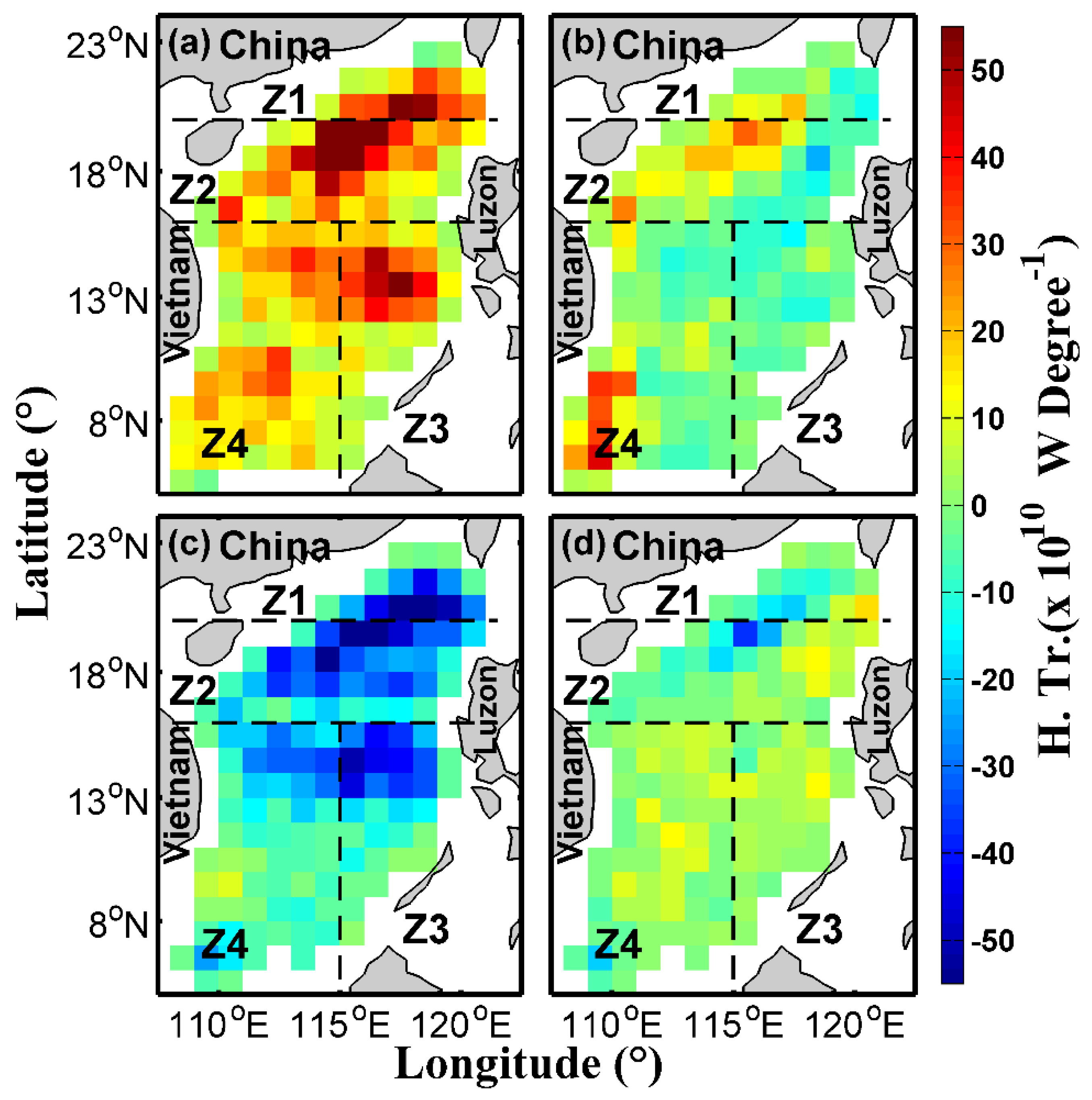

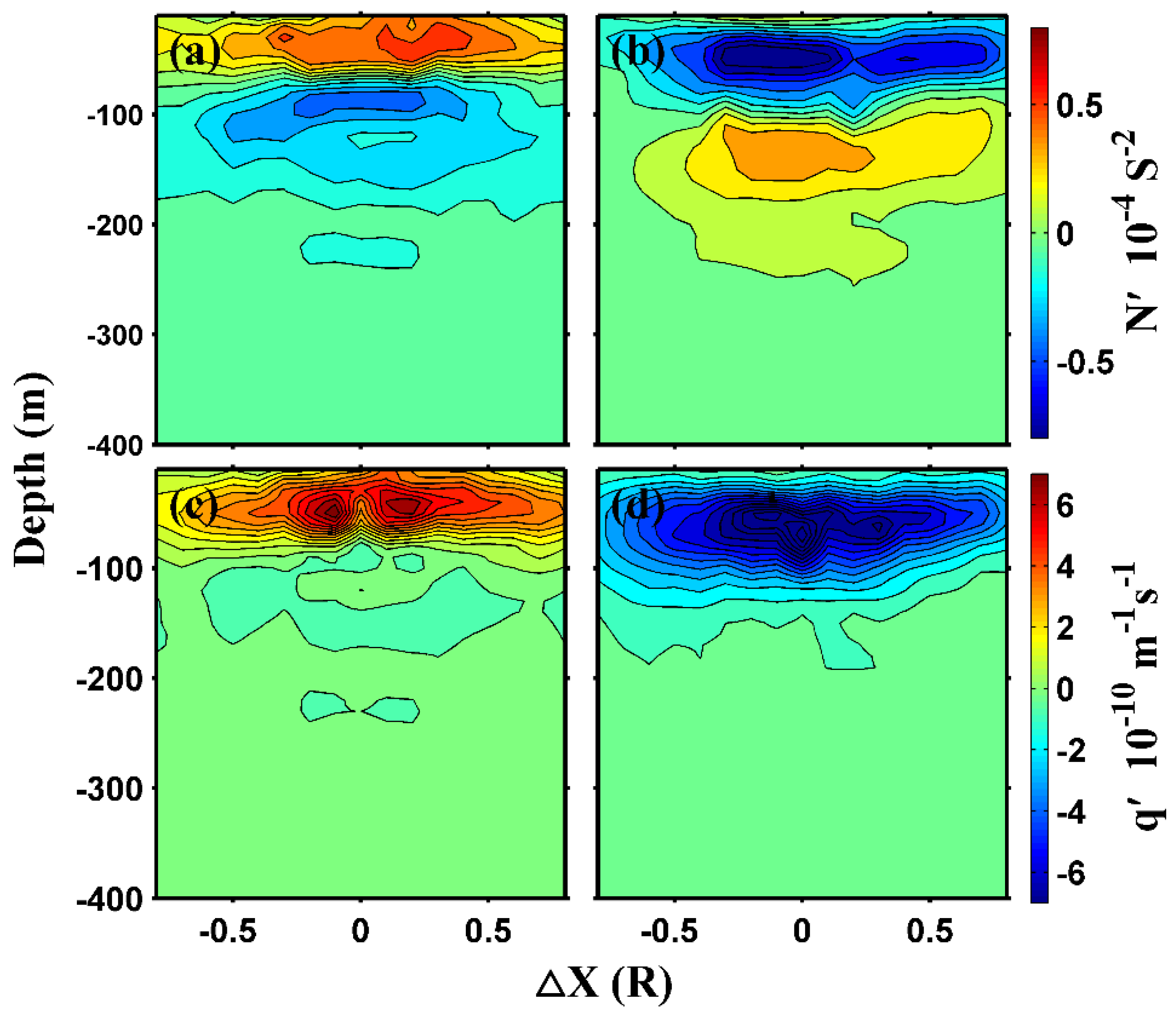
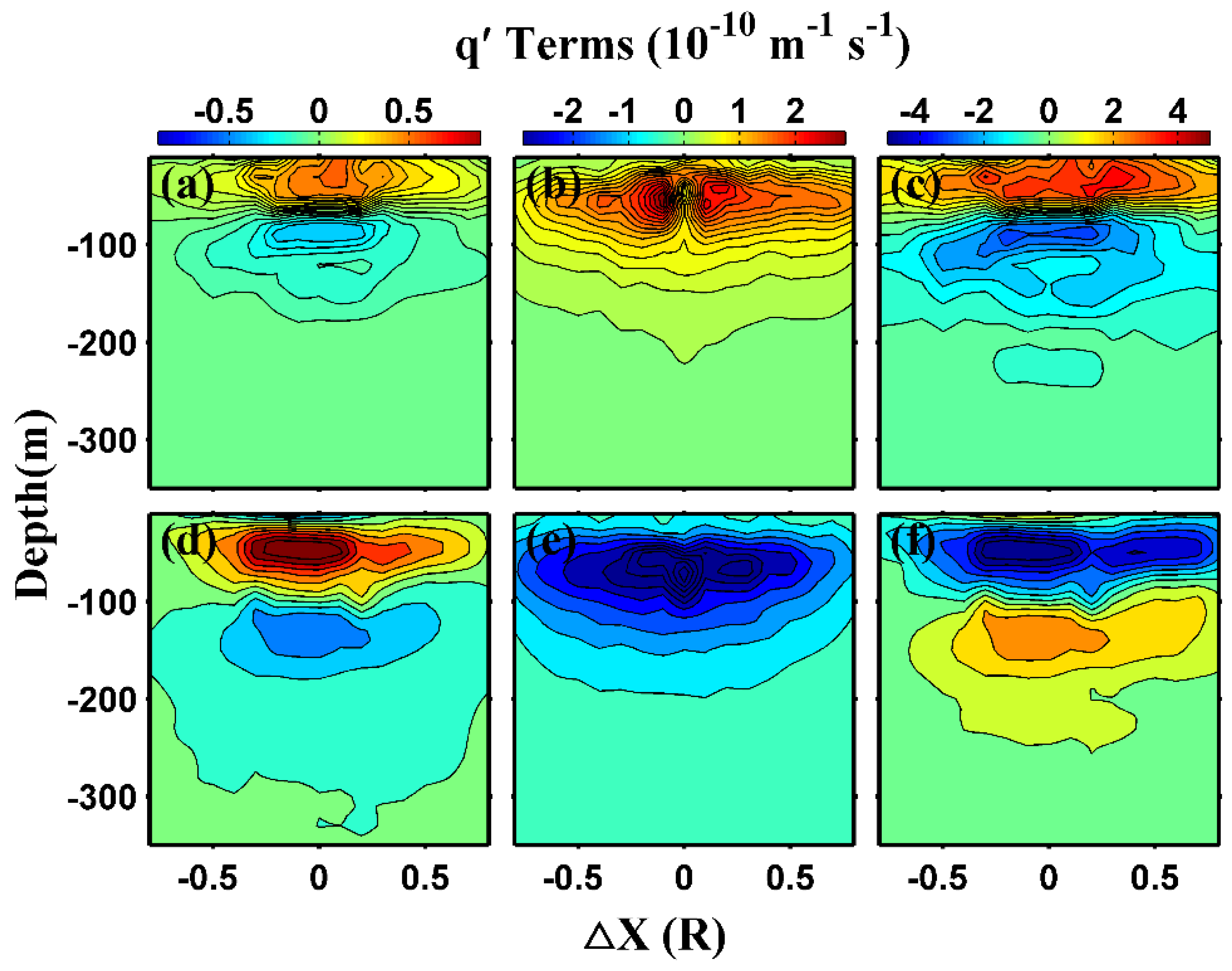
© 2018 by the authors. Licensee MDPI, Basel, Switzerland. This article is an open access article distributed under the terms and conditions of the Creative Commons Attribution (CC BY) license (http://creativecommons.org/licenses/by/4.0/).
Share and Cite
Sun, W.; Dong, C.; Tan, W.; Liu, Y.; He, Y.; Wang, J. Vertical Structure Anomalies of Oceanic Eddies and Eddy-Induced Transports in the South China Sea. Remote Sens. 2018, 10, 795. https://doi.org/10.3390/rs10050795
Sun W, Dong C, Tan W, Liu Y, He Y, Wang J. Vertical Structure Anomalies of Oceanic Eddies and Eddy-Induced Transports in the South China Sea. Remote Sensing. 2018; 10(5):795. https://doi.org/10.3390/rs10050795
Chicago/Turabian StyleSun, Wenjin, Changming Dong, Wei Tan, Yu Liu, Yijun He, and Jun Wang. 2018. "Vertical Structure Anomalies of Oceanic Eddies and Eddy-Induced Transports in the South China Sea" Remote Sensing 10, no. 5: 795. https://doi.org/10.3390/rs10050795
APA StyleSun, W., Dong, C., Tan, W., Liu, Y., He, Y., & Wang, J. (2018). Vertical Structure Anomalies of Oceanic Eddies and Eddy-Induced Transports in the South China Sea. Remote Sensing, 10(5), 795. https://doi.org/10.3390/rs10050795






